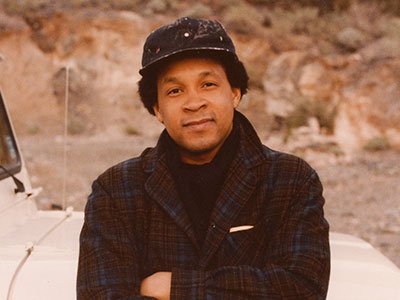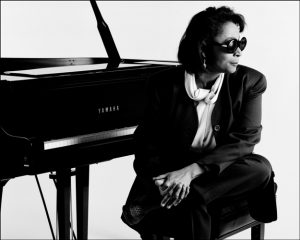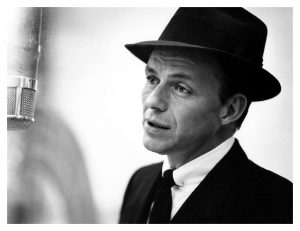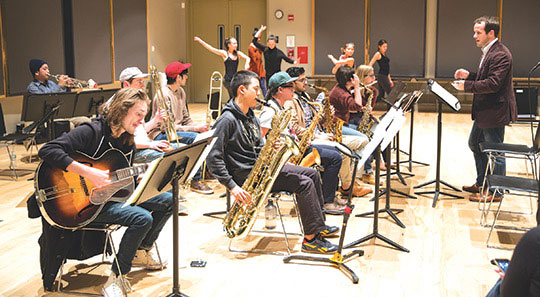
Yet the younger Brown chose Fordham’s McGinley Ballroom for the benefit event on Saturday, Oct. 20, because of one quality that thrives in the neighborhoods and people that surround the Rose Hill campus—diversity.
“We’re trying to shine a light on a story that hasn’t really been told,” said Brown, who conceived the idea for the event, which he dubbed “120 Wooster Street,” with his longtime mentor, Mark Naison, Ph.D., professor of history and African American Studies.
“We want to recreate a time period, and show students, faculty, administrators, and people from the [Bronx] community what it was really like in 1970s SoHo, and do it in a way that incorporates art and music.”
Prints and original works by the artist will be on sale at the event; proceeds will benefit the Bronx African American History Project, which Naison directs and where Brown served as a researcher during his time at Fordham.
Shining a Light on the 1970s SoHo Art Scene
Now a graduate researcher at New York University, Brown said the Bronx seemed like a natural fit, since the art, music, fashion, and even food culture of the borough’s black and brown residents are often left out of the larger narrative of culture in New York City.
The same could be said of SoHo’s 1970s art scene, Brown said.
“That era [of the art and music scene has]often been told from a white perspective, but the reality is that the black artists were the creatives, the avant-garde. That was a time and space where black artists were creating the style of the times,” he said.
Frederick James Brown (1945–2012) was a New York City and Arizona-based American artist whose work engaged with American history, music, urban life, and spirituality. He was the first American artist to display his works at what is now the National Museum of China.
Born in Georgia and raised on Chicago’s South Side, he studied art and psychology at Southern Illinois University. He taught for several years in Chicago and Carbondale, Illinois, and traveled to Europe in 1969. In 1970, he moved to New York’s SoHo district to become a professional painter, supporting himself by teaching part-time at the Brooklyn Museum, York College, and the School of the Visual Arts.
Brown’s paintings of the early 1970s were large, bold abstractions based on the abstract expressionist tradition of the art department at Southern Illinois University. In 1975 Brown met the noted American painter Willem de Kooning, whom he would go on to refer to as his “artistic godfather.”
Brown settled in a loft in SoHo during the New York art renaissance of the 1970s and 1980s. There, he collaborated with jazz musicians like Ornette Coleman and Anthony Braxton.
It was a return to his formative years, the younger Brown said.

“My father wasn’t musically inclined, but he grew up around it as Southside Chicago was a hotbed for black music,” he said. “My grandfather owned a shoe shine parlor and juke joint. My dad met all those people growing up, such as the folks behind Chess Records, who made Muddy Waters and Etta James the household names they were.”
Thus, his art began immortalizing the jazz musicians, mentors, and colleagues who had exerted the greatest influence on his life.
“He had switched to more figurative work. He and a few others were pioneers of what became figurative expressionism,” Brown said. “Folks may be familiar with Jean Michele Basquiat, but my father had started long before him. And then from there he moved into portraiture of the jazz figures. These musicians aren’t just musicians, but people, and heroes of the American narrative.”
With this Fordham event, Brown wants to continue his father’s legacy of illuminating that narrative.
Honoring a Tradition of Art and Music
A selection of Frederick Brown’s works will be on display at the Oct. 20 event at Fordham, which goes from 6:30 p.m. to 11 p.m. Admission is free and open to the public.
Apropos of the artist’s work, there will also be music, courtesy of the Dale Fielder jazz quartet, organized by Kunle Mwanga, who once served as manager for Ornette Coleman. Brown also plans to tease a documentary he is working on for his dissertation about SoHo and black creative spaces.
The evening, emceed by Naison, will begin with a talk by the American poet, community activist, journalist, media personality, and politician Felipe Luciano.
“He and my dad were like brothers,” Brown said. “Felipe was coming up as a poet when my dad was painting.”
Brown said that his academic home of four years was a perfect place to cast a new light on the art scene that his father helped to define.
“I think that’s what academia is supposed to do—shift the way that we perceive things,” he said.
]]>
To honor Fordham’s Bronx connection, the University will host its Second Annual Bronx Celebration Day on Saturday, April 21, with a focus on uniting the diverse cultures within the borough and bringing them together with Fordham and the surrounding communities. The event gives Fordham a chance to get to know its Bronx neighbors while also enjoying local performing artists and vendors.
This fun-filled day will be headlined by Puerto Rican bomba and plena collective Grupo Bámbula, Dominican musicians Yasser Tejada & Palotré, Honduran cultural music group Bodoma Garífuna Cultural Band, Italian percussionist-dancer-singer Alessandra Belloni, and other local Bronx performers. There will also be hip-hop and spoken word performances, Mexican folkloric dance, and more.
Several local artisans will sell original art, and community organizations such as Run for Fun International and the Bronx Children’s Museum will be on hand to discuss their services and offer several ways members of the Fordham community can get involved in life off campus.
And there will be food!
Campus Tours
The community is invited to take campus tours. Fordham has been serving the community for many years, and always looking to increase interaction and personal connections between the on-campus community and neighbors in the surrounding area. To this end, on Bronx Celebration Day, the University invites the community to take tours of the Rose Hill campus.
Register for a FREE Bronx Celebration Day event ticket here. Read our story about last year’s event. For more information, email Natalie Wodniak at [email protected].
Free Jazz Performance after Bronx Celebration Day
That same evening, the University is hosting a jazz concert featuring two of the Bronx’s finest jazz musicians: pianist and composer Valerie Capers and pianist/singer/composer Judy Carmichael. Both of these artists are great personalities and music historians as well as performers and will have great musicians backing them up.

This event is is also free and open to the public. It is sponsored by the Bronx African American History Project and co-sponsored by the Bronx Music Heritage Center. It will take place from 7 to 10 p.m. in the McGinley Center Ballroom. More information here.
]]>
The assistant professor in the Department of Art History and Music said he infuses the classical tradition with a “jazz edge.” And it’s not just his music that departs from a purely classical approach, but also his teaching.
“You’re not studying music necessarily to become concert pianist, that’s a very old fashioned and narrow conservatory approach,” he said. “Music is just like anything else in the humanities; there’s not an exact job that corresponds to an English major. This is not a pre-professional training program or trade school.”
Fordham’s instruction, in fact, offers music students a broad humanities education along with any focus on performance, he said.
 Lincoln-DeCusatis will be giving a preshow talk on Frank Sinatra to alumni attending the “Sinatra at 100” concert at Jazz at Lincoln Center as part of a sold out Fordham Alumni Culture and Entertainment event. The event marks the centenary of Sinatra’s birth. He said he would focus on Sinatra’s comeback in the 1950s.
Lincoln-DeCusatis will be giving a preshow talk on Frank Sinatra to alumni attending the “Sinatra at 100” concert at Jazz at Lincoln Center as part of a sold out Fordham Alumni Culture and Entertainment event. The event marks the centenary of Sinatra’s birth. He said he would focus on Sinatra’s comeback in the 1950s.
“One thing that falls in the scholarship is there is this interregnum between the end of the big band era with jazz and the beginning of rock and roll with Elvis,” he said.
“There’s about 10 years between the end of World War II and the mid-1950s where it was all about the Rat Pack Era with Sinatra, Sammy Davis, and Dean Martin.”
It was also a period in which musicians frequently mixed jazz and classical, as Lincoln-DeCusatis does today.
“My take is there aren’t as many boundaries between those things as you would think,” he said.
Through a Fordham Faculty Research grant, Lincoln-DeCusatis is working with an ensemble composition that blends big band and chamber classical. He said it’s written for 10 musicians and is a long piece with jazz improv that straddles both worlds.
The structure of classical music and free form of jazz improvisation aptly describes Sinatra’s musicality, he said. But he stressed that whether someone improvises, or whether someone even reads music, should not be taken as a reflection of his or her musical intellect.
“Sinatra wasn’t as fluent a music reader as you think,” he said. “But had an encyclopedic musical knowledge. Think of all the tunes that he just knew off the top of his head.”
More importantly, he said, in an age when vibrato and showiness reigns as a sign of musicality, Sinatra was a subtle interpreter.
“We like to think of this guy as a musical genius who was just naturally gifted, but that’s actually a myth,” he said. “Frank Sinatra was someone who worked incredibly hard at his craft to develop his voice (and) expand his range, and he did this very, very carefully.
“For him it wasn’t about this virtuosic Mariah Carey style of musical delivery where it’s all over the place,” he said. “Something we lost in popular song that Sinatra had was a simple, clean style.”
Lincoln-DeCusatis said that Fordham has traditionally taught music by stressing history and theory, essentially couching it within the humanities. But now the program includes the more creative aspects, such as performance, composition, and improvisation. While he still teaches music theory and jazz traditions, he also provides classroom support for Fordham’s collaboration with Jazz at Lincoln Center.
Recently he has partnered with the Department of Communication and Media Studies to create a production class for electronic music. The music department equipped the communication department’s state-of-the-art computer lab with keyboards and appropriate software.
“This first class is a good split between music and communication majors and some Gabelli students in there, too, who want to make beats,” he said.
The class, he said, shows one of the many opportunities that open up to music majors when they begin to “piece things together” to seek a niche in today’s competitive and diverse music industry.
“Fordham offers this broad education that makes you a well-rounded and cultured person in general, but it’ll also support you intellectually in anything you decide to do,” he said.
Music and technology will only grow in the coming years, he said. In addition to New York’s having a burgeoning tech sector, the city remains a center of the performing arts world, one that hires as much—if not more—for the back of the house as it does for the stage.
]]>Members of the chamber jazz ensembles recently performed two sets from their current repertoire on Nov. 8 at JALC’s Ertegun Atrium prior to performances of “Celebrating Bobby Hutcherson: Life of a Legend.”
]]>
Fordham’s Westchester campus, draped in fall colors.
Photo by Grant Grastorf.
Fordham Westchester will host a Fall Open House on Tuesday, Oct. 30 from 4:30 p.m.- 6:30 p.m. in celebration of its fifth year in West Harrison, N.Y. and over 35 years in Westchester.

The golf tee columns loom.
Photo by Bill Denison
Come enjoy peak autumn colors at the 32-acre hilltop campus and tour the Modernist gem of a building designed by architect Victor Bisharat. Born in Jerusalem and educated at Berkley, Bisharat’s work is not well known outside of Connecticut. The New York Times said he was the “architect most closely associated with Stamford’s commercial development” from the late 1960s through the 1970s. And Stamford Magazine credited him for bringing a “Modernist celebration of cutting-edge space age architecture” to that city’s skyline.
Bisharat, who died in 1996, brought his space age zing to Harrison, New York in 1967. Initially built for a long-gone telephone company, the building’s golf tee-like columns and demi-moon balconies were restored during Fordham’s renovation. The project won BOMA Westchester’s 2009 Building of the Year award.
The campus quickly settled into its role as one of the area’s leading institutions and the festivities will celebrate the community with live jazz, food, and prizes. Fordham representatives will be on hand to answer questions about the undergraduate programs, as well as master’s degree programs in business administration, education, religion and religious education, and social service.For further information contact Grant Grastorf, [email protected] or (914) 367-3202.
-Tom Stoelker
]]>In addition to her renowned body of work as a jazz pianist, McPartland is the longtime host of Piano Jazz, which airs on National Public Radio, and author of several books, including Marian McPartland’s Jazz World: All in Good Time. She was recognized for her dedication to promoting music education in public schools when inducted into the International Association of Jazz Education Hall of Fame in 1986. In 2001, McPartland was presented with the National Music Council’s American Eagle Award and the Gracie Allen Award, given annually by American Women in Radio and Television.
DATE: WEDNESDAY, FEB. 2
TIME: 4 P.M.
PLACE: DUANE LIBRARY-ROSE HILL CAMPUS
FORDHAM UNIVERSITY
441 FORDHAM ROAD, BRONX, N.Y.
Fordham University will present McPartland with the Sapientia et Doctrina Medallion at the performance. Fordham University’s motto, Sapientia et Doctrina (Wisdom and Learning), emphasizes rigorous scholarship and embraces a community of men and women committed to exploring the life of the mind.
]]>
